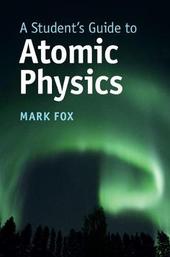
|
A Student's Guide to Atomic Physics
Hardback
Main Details
| Title |
A Student's Guide to Atomic Physics
|
| Authors and Contributors |
By (author) Mark Fox
|
| Series | Student's Guides |
|---|
| Physical Properties |
| Format:Hardback | | Pages:292 | | Dimensions(mm): Height 235,Width 155 |
|
| Category/Genre | Optics
Atomic and molecular physics
Applied optics |
|---|
| ISBN/Barcode |
9781107188730
|
| Classifications | Dewey:539.7 |
|---|
| Audience | | Tertiary Education (US: College) | | Professional & Vocational | |
|---|
| Illustrations |
Worked examples or Exercises; 27 Tables, black and white; 21 Halftones, black and white; 62 Line drawings, black and white
|
|
Publishing Details |
| Publisher |
Cambridge University Press
|
| Imprint |
Cambridge University Press
|
| Publication Date |
14 June 2018 |
| Publication Country |
United Kingdom
|
Description
This concise and accessible book provides a detailed introduction to the fundamental principles of atomic physics at an undergraduate level. Concepts are explained in an intuitive way and the book assumes only a basic knowledge of quantum mechanics and electromagnetism. With a compact format specifically designed for students, the first part of the book covers the key principles of the subject, including the quantum theory of the hydrogen atom, radiative transitions, the shell model of multi-electron atoms, spin-orbit coupling, and the effects of external fields. The second part provides an introduction to the four key applications of atomic physics: lasers, cold atoms, solid-state spectroscopy and astrophysics. This highly pedagogical text includes worked examples and end of chapter problems to allow students to test their knowledge, as well as numerous diagrams of key concepts, making it perfect for undergraduate students looking for a succinct primer on the concepts and applications of atomic physics.
Author Biography
Mark Fox is a Professor of Physics at the University of Sheffield. He is also a Fellow of the Optical Society of America, and the Institute of Physics. His research focuses on optics and photonics, and he specialises in solid-state atoms and quantum dots. He has authored two highly successful books: Optical Properties of Solids (2nd edition, 2010) and Quantum Optics: An Introduction (2005).
Reviews'Today a thorough understanding of atomic and molecular physics is surely a prerequisite for a career in astrophysics, especially now that the entire electromagnetic spectrum of many astronomical objects may be open to quantitative examination. Given the need for a sound understanding, the question becomes, how are students to develop a serious interest in atomic and molecular physics? This book by Mark Fox deserves consideration for an atomic-physics course taken by physics (and other) students in the second half of their undergraduate career ... I welcome this book for its clear exposition of the basic ideas on atomic structure and spectra. ... The health of spectroscopic astrophysics demands that young bright minds are brought into the field in every generation. Texts like that by Mark Fox have a crucial role to play in this context.' David L. Lambert, The Observatory 'Well-chosen worked examples are liberally sprinkled through all the chapters. This is an invaluable aid to the reader ... The text is clear to read and understand, and only a basic understanding of quantum mechanics and electromagnetism is required ... The harder mathematical concepts are hidden away in Appendices, so they are still available for the more intrepid reader, but do not spoil the flow of the main text ... I would agree that the material is pitched at the second or third year of a UK undergraduate physics course, but it would also be useful for specialists in other fields starting out in the world of atomic physics.' Stephen H. Ashworth, Contemporary Physics 'This is a well-constructed book with a great many exercises at the end of each chapter. These exercises are of tremendous value, enabling students to solve a wide variety of problems in the subject. I would recommend this book for anyone who wanted a basic understanding of atomic physics.' Trevor Bailey, Mathematics Today
|